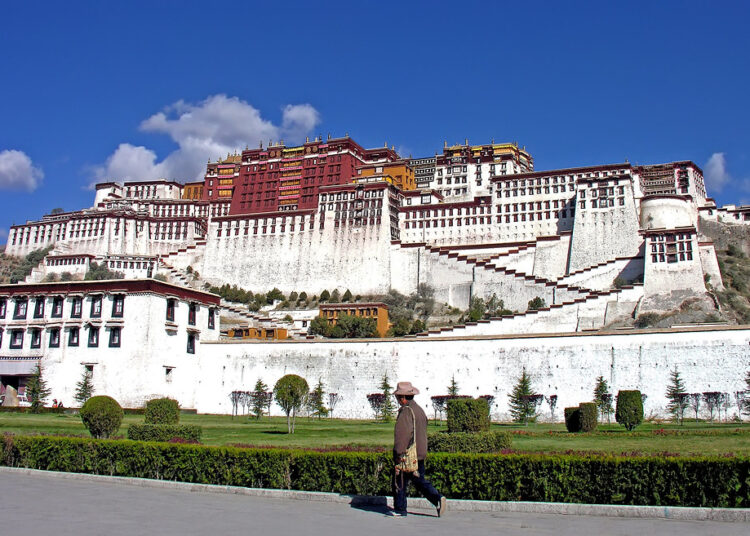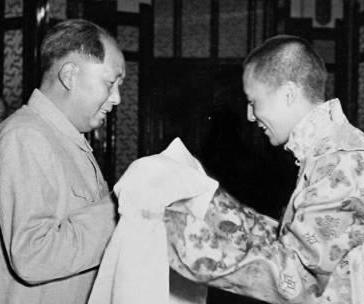It is only recently that I discovered that the Dalai Lama is a very rich individual, worth approximately $150 million dollars. The fact is jarring, used as I am to think of him as the spiritual leader of Buddhism, a religion that preaches and practices asceticism and the renunciation of material goods.
Born on July 6, 1935, Lhamo Thondup’s life–to give him his birth name–changed in 1940 when he was taken to the Potala Palace, where he was officially installed as the spiritual leader of Tibet. Soon after, the newly recognized Dalai Lama was taken to the Jokhang temple where he was inducted as a novice monk in a ceremony known as taphue, meaning cutting of the hair. “From now on, I was to be shaven-headed and attired in maroon monk’s robes” he has written. In accordance with ancient custom, His Holiness forfeited his name Lhamo Thondup and assumed a new name, Jamphel Ngawang Lobsang Yeshe Tenzin Gyatso. In 1959, after the Chinese occupation of Tibet, the Dalai Lama went into exile and established a Tibetan government in exile in Dharamshala, India where he currently resides.

What we frequently fail to take into account is that the Dalai Lama serves not only as the religious leader of the Gelung school of Tibetan Buddhism but also as the leader and the symbol of unification for the state of Tibet. He is therefore, like a President in addition to a Prophet. Much like the Pope, he plays an important role in international politics. The difference is that we’re used to connect the Pope with wealth, Catholicism being the wordliest religion, and the Vatican historically associated with corruption and decadence.
The question is, where does the Dalai Lama’s money come from? And how has someone who dedicated his life to compassion, thought, teaching, and religion have a net worth higher than many Hollywood celebrities?
The Dalai Lama retains most of his wealth through being the leader of Tibet. He did retire as political head in 2011 though, to make way for a democratic government. Part of the worth also comes from cultural significance as the author of a vast collection of over 58 published books and the subject of seven feature film documentaries.
Another part of the worth comes from the cultural significance provided through several awards and honors. His Holiness was awarded the Nobel Peace Prize in 1989, the US Congressional Gold Medal in 2006, the Templeton Prize in 2012, the Ahimsa Award in 2007, the Freedom Medal in 1994, and the Ramon Magsaysay Award in 1959. Most of these awards come with a monetary prize.

As a pragmatist, the Dalai Lama tries to reconcile the value attached to wealth with the spirituality associated with one of the most ascetic religions on earth. “Money is good,” said His Holiness. “It is important. Without money, daily survival – not to mention further development – is impossible. So, we are not even questioning its importance. At the same time, it is wrong to consider money a god or a substance endowed with some power of its own. To think that money is everything, and that just by having lots of it all our problems will be solved is a serious mistake.”
The annexation of Tibet by the Chinese complicated the 14 generations of tradition that have dictated the selection and role of the Dalai Lama. Especially in order to circumvent the interference of the Chinese government, he has stated that a Dalai Lama may no longer be needed, that he would transfer his spiritual powers prior to his death into the next incarnation, that the next Dalai Lama would be born outside of Tibet and abroad, most likely in India, or that the next incarnation may be reborn as a woman. While all of these remain a possibility, the future of the Dalai Lama is uncertain.

So how is the money spent? His Holiness founded the Gaden Phodrang Foundation of the Dalai Lama, which, according to its mission statement, “aims to promote basic human values, mutual understanding among religions, peace and non-violence and the protection of the environment. It helps to preserve the unique Tibetan culture and supports the Tibetan people, but also other people in need, regardless of nationality, religion and origin. The Foundation also promotes a better understanding between science and religion, supports efforts to provide access to knowledge from Buddhist science and philosophy and funds a wide range of translation work and publications are funded.”
It is reassuring to know that the money will pass on to the next Dalai Lama through the Foundation, and that it will continue to be used for charitable and humanitarian purposes. As the Dalai Lama, has stated, “Money is good” but we can surely add: “when it’s used for good purposes.”












